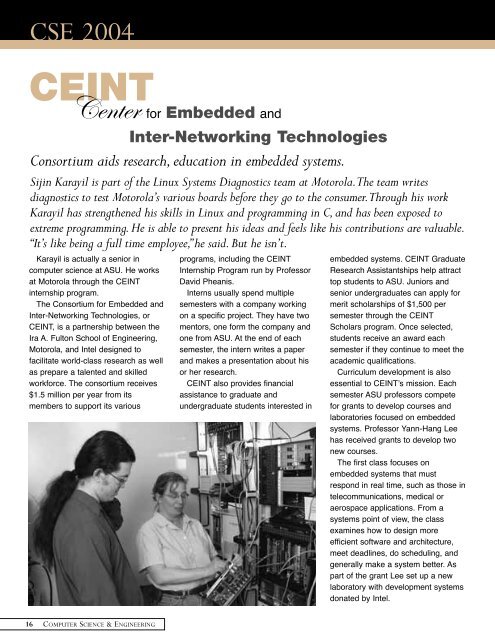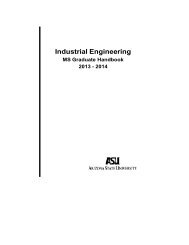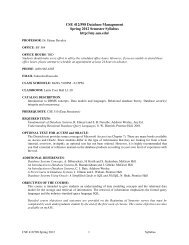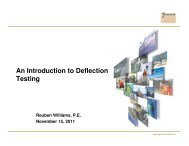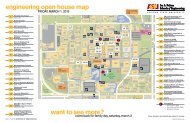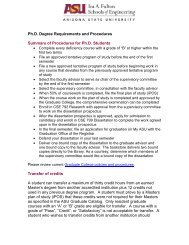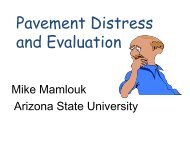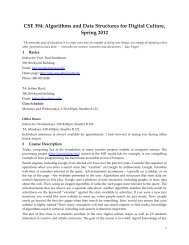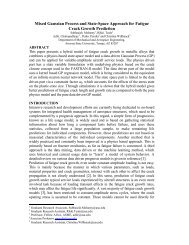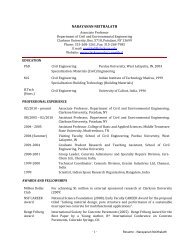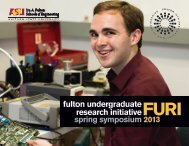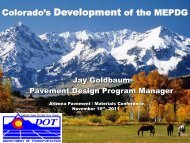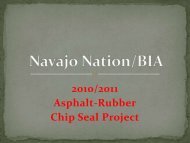2003-2004 Department of Computer Science and Engineering
2003-2004 Department of Computer Science and Engineering
2003-2004 Department of Computer Science and Engineering
You also want an ePaper? Increase the reach of your titles
YUMPU automatically turns print PDFs into web optimized ePapers that Google loves.
CSE <strong>2004</strong>CEINTCenter for Embedded <strong>and</strong>Inter-Networking TechnologiesConsortium aids research, education in embedded systems.Sijin Karayil is part <strong>of</strong> the Linux Systems Diagnostics team at Motorola.The team writesdiagnostics to test Motorola’s various boards before they go to the consumer.Through his workKarayil has strengthened his skills in Linux <strong>and</strong> programming in C, <strong>and</strong> has been exposed toextreme programming. He is able to present his ideas <strong>and</strong> feels like his contributions are valuable.“It’s like being a full time employee,” he said. But he isn’t.Karayil is actually a senior incomputer science at ASU. He worksat Motorola through the CEINTinternship program.The Consortium for Embedded <strong>and</strong>Inter-Networking Technologies, orCEINT, is a partnership between theIra A. Fulton School <strong>of</strong> <strong>Engineering</strong>,Motorola, <strong>and</strong> Intel designed t<strong>of</strong>acilitate world-class research as wellas prepare a talented <strong>and</strong> skilledworkforce. The consortium receives$1.5 million per year from itsmembers to support its variousprograms, including the CEINTInternship Program run by Pr<strong>of</strong>essorDavid Pheanis.Interns usually spend multiplesemesters with a company workingon a specific project. They have twomentors, one form the company <strong>and</strong>one from ASU. At the end <strong>of</strong> eachsemester, the intern writes a paper<strong>and</strong> makes a presentation about hisor her research.CEINT also provides financialassistance to graduate <strong>and</strong>undergraduate students interested inembedded systems. CEINT GraduateResearch Assistantships help attracttop students to ASU. Juniors <strong>and</strong>senior undergraduates can apply formerit scholarships <strong>of</strong> $1,500 persemester through the CEINTScholars program. Once selected,students receive an award eachsemester if they continue to meet theacademic qualifications.Curriculum development is alsoessential to CEINT’s mission. Eachsemester ASU pr<strong>of</strong>essors competefor grants to develop courses <strong>and</strong>laboratories focused on embeddedsystems. Pr<strong>of</strong>essor Yann-Hang Leehas received grants to develop twonew courses.The first class focuses onembedded systems that mustrespond in real time, such as those intelecommunications, medical oraerospace applications. From asystems point <strong>of</strong> view, the classexamines how to design moreefficient s<strong>of</strong>tware <strong>and</strong> architecture,meet deadlines, do scheduling, <strong>and</strong>generally make a system better. Aspart <strong>of</strong> the grant Lee set up a newlaboratory with development systemsdonated by Intel.16 COMPUTER SCIENCE & ENGINEERING


